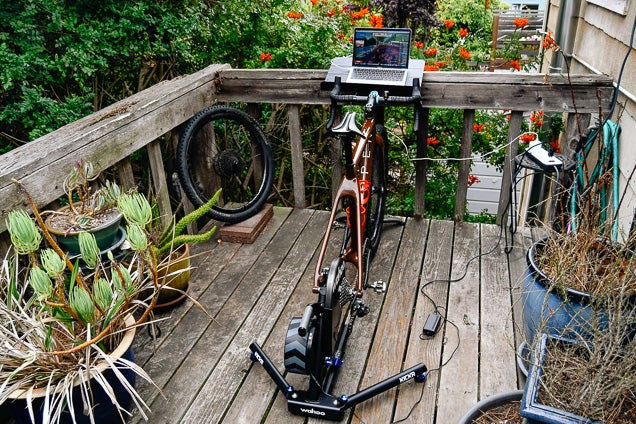There are some pairings in life that seem unlikely on their own but become surprisingly delightful together. Think gin and tonic, blue cheese and pears, and, now, for me, gaming and cycling on a smart trainer. Like many cyclists, I initially scoffed at the idea of indoor training, but the Best Bike Trainer has completely changed my perspective.
What exactly is a smart trainer? Simply put, a bike trainer is a device that transforms your regular bicycle into a stationary bike, replacing the rear wheel and allowing you to pedal as intensely as you want without moving forward. A smart trainer elevates this experience by automatically adjusting resistance. Connected via Bluetooth to apps on your laptop or tablet, these trainers simulate the gradients of virtual terrains, from steep mountain climbs to fast-paced races against online competitors. For years, professional cyclists and dedicated amateurs have utilized trainers for indoor workouts during inclement weather. This was precisely why I initially dismissed them. I’ve always been an avid outdoor cyclist, embracing all weather conditions. Ten years ago, I bought my first road bike to escape the soul-crushing commute from San Francisco to Menlo Park. Rain or shine, a group of us would cycle together before dawn, sharing drafts and covering 30-40 miles to work. Canceling a ride due to rain was almost unthinkable, a sign of weakness. As my cycling buddy Peter would say, “Bikes don’t melt.” There’s even a cycling adage, Rule #9, that celebrates riding in bad weather as a mark of toughness. Indoor trainers, therefore, seemed like a less courageous option, an admission of defeat to the elements.
Gaming, too, was something I had consciously avoided. I’d read articles about hikikomori, the reclusive Japanese youth who withdraw from society to spend years playing video games. Knowing my susceptibility to immersive narratives and fictional worlds, I steered clear of games like Myst and Minecraft, fearing they might consume too much of my time.
Then, as we all experienced, the pandemic arrived. Initially, bike rides around the city provided a welcome escape. However, as trails became crowded with pedestrians and cyclists, the atmosphere shifted, filled with tension and masked faces. The simple act of riding outdoors became fraught with anxiety. Adding to this was the increased danger on the roads. With traffic significantly reduced, the remaining drivers treated city streets like racetracks. The risk of accidents and overburdening already strained hospitals became a genuine concern.
My boyfriend, a former racer with a history of disliking traditional trainers, relented in early April. He purchased a Wahoo Kickr smart trainer, setting it up in our living room. He subscribed to Zwift, a multiplayer online cycling game where users can race, follow training plans, or explore virtual worlds inspired by real locations like London, Innsbruck, and France, along with the fantastical Watopia. I watched with skepticism as he sweated through indoor workouts, his screen displaying a car-free virtual road ahead.
 A bike mounted on a smart trainer on a balcony, showcasing a home indoor cycling setup for using the best bike trainer apps like Zwift.
A bike mounted on a smart trainer on a balcony, showcasing a home indoor cycling setup for using the best bike trainer apps like Zwift.
It wasn’t until he moved the Kickr to our back deck – requiring a Wi-Fi extender and a repurposed music stand for his laptop – that the magic truly happened. I brought my own bike and laptop outside, connected my bike to the Kickr, clipped in, and spent an hour cycling through a virtual “Central Park,” cooled by the San Francisco breeze and fog rolling in from Twin Peaks. Since then, I’ve been riding four to five times a week, accumulating over 52 hours and 743 miles. I’ve completed one 12-week training program and started another, earning over 625,000 “drops” in Zwift, which I can use to purchase virtual upgrades for my avatar. Gamification as motivation, I can attest, truly works. And unlike my fears about losing myself in online worlds, this one demands physical exertion.
Like many, I’ve relied on Zoom to stay connected with family and friends. Sunday evenings are now reserved for calls with my parents and brother, more frequent than our pre-pandemic phone calls. My cycling friends from those early commutes, however, are now geographically scattered: me in San Francisco, Peter and his wife Christine temporarily in Banff, and Marion back in Germany. Time differences make real-time video calls challenging.
However, Zwift offers a solution: group rides. The game uses a “rubber-banding” feature that keeps our avatars together. If Peter surges ahead on a virtual climb, as he often does in real life, the game gently pulls him back to the group. This way, we can explore virtual and real-inspired landscapes together and even tackle Mont Ventoux as a group, just as we did years ago in France. In-game chat is available but requires typing on a phone, which feels distracting while cycling. We’ve considered Discord for voice chat, but haven’t tried it yet. For me, and I suspect for them, simply riding together on the virtual road is enough. No talking needed, just pedaling in familiar cadence, watching my friend’s avatar, still recognizable, leading the way home. Discovering the best bike trainer has not only kept me cycling during challenging times but has also unexpectedly enhanced my connection to friends, proving that sometimes, the most unlikely combinations can bring the greatest joy.

